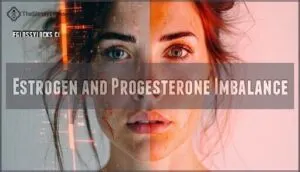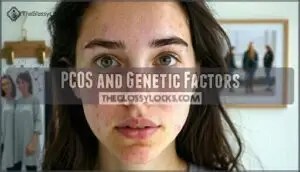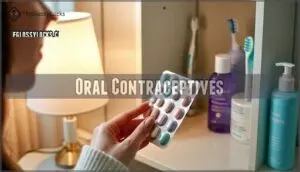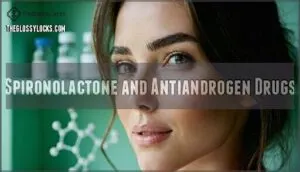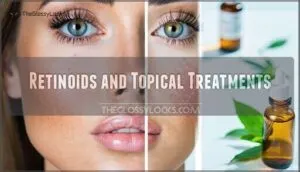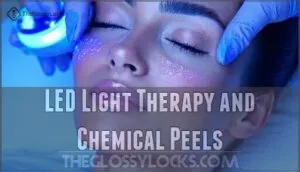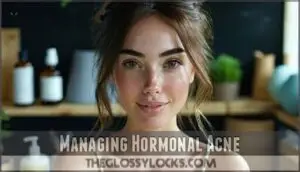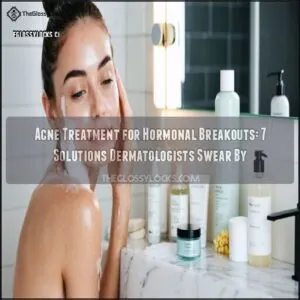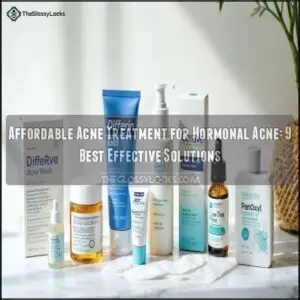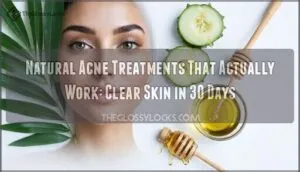This site is supported by our readers. We may earn a commission, at no cost to you, if you purchase through links.
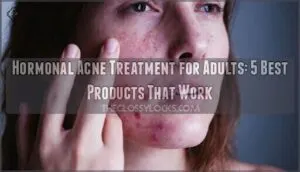 You’re dealing with hormonal acne treatment for adults when your breakouts cluster around your jawline and chin, refusing to budge despite your best efforts.
You’re dealing with hormonal acne treatment for adults when your breakouts cluster around your jawline and chin, refusing to budge despite your best efforts.
Unlike teenage acne, adult hormonal breakouts stem from fluctuating estrogen, progesterone, and androgen levels that trigger excess oil production and inflammation.
Effective treatments target both the hormonal root cause and surface symptoms through retinoids, salicylic acid, benzoyl peroxide, and sometimes prescription medications like spironolactone or birth control.
The key lies in understanding your specific hormonal patterns and choosing products that work synergistically rather than fighting each other.
Table Of Contents
- Key Takeaways
- Causes of Hormonal Acne
- Treating Hormonal Acne
- 5 Best Treatments for Adults
- Managing Hormonal Acne
- Frequently Asked Questions (FAQs)
- How do you get rid of hormonal acne in adults?
- Which treatment is best for hormonal acne?
- What is the best routine for hormonal acne?
- What is the first line of treatment for hormonal acne?
- Can hormonal acne appear during pregnancy?
- How long does hormonal acne treatment take?
- Are there natural remedies for hormonal acne?
- Does diet affect hormonal acne severity?
- Can men develop hormonal acne too?
- Conclusion
Key Takeaways
- Target the root cause with hormonal treatments – You’ll need oral contraceptives, spironolactone, or antiandrogen drugs to regulate fluctuating estrogen, progesterone, and androgen levels that trigger your breakouts.
- Start with proven topical treatments – Use salicylic acid cleansers, benzoyl peroxide, and retinoids like adapalene to unclog pores and reduce inflammation while your hormones stabilize.
- Expect a 3-6 month timeline – You won’t see significant improvement overnight, but consistent treatment for at least 12 weeks will deliver meaningful results for stubborn adult acne.
- Support treatment with lifestyle changes – Manage stress, improve gut health with probiotics, and maintain a consistent skincare routine to maximize your treatment’s effectiveness.
Causes of Hormonal Acne
Understanding what triggers your hormonal acne is the first step toward finding treatments that actually work.
Your breakouts aren’t just random bad luck—they’re your body’s response to specific hormonal shifts that affect oil production, inflammation, and bacterial growth in your pores, which is a key factor to consider for effective treatments.
Hormonal Fluctuations
Your body’s hormonal fluctuations create a perfect storm for adult acne breakouts.
When hormones spiral out of control, your skin becomes their battleground.
These natural shifts affect oil production, inflammation, and bacterial growth in your skin.
Here’s when hormonal fluctuations typically trigger acne:
- Menstrual Cycle – Testosterone spikes before your period, increasing oil production
- Pregnancy Acne – Rising progesterone levels stimulate sebaceous glands during pregnancy
- Menopause Impact – Declining estrogen allows androgen levels to dominate, worsening breakouts
The cortisol connection from stress compounds these effects, making hormonal imbalance acne more severe.
Estrogen and Progesterone Imbalance
Two key hormones control your skin’s oil production, and their imbalance triggers adult acne.
When estrogen drops during menstruation or menopause, your skin produces more oil. Meanwhile, progesterone spikes during ovulation can worsen breakouts by stimulating sebaceous glands.
Your hormones directly control your skin’s oil production—when they’re out of balance, breakouts follow.
| Hormone | Effect on Acne |
|---|---|
| Estrogen Deficiency | Increases oil production, reduces skin’s natural protection |
| Progesterone Excess | Stimulates sebaceous glands, creates inflammatory environment |
| Cycle Irregularities | Unpredictable breakouts, difficulty timing hormonal acne treatment |
| Menopause Phase | Persistent adult acne due to declining estrogen levels |
PCOS and Genetic Factors
If you have PCOS, your genetic predisposition substantially increases your risk of developing hormonal acne.
Family history matters—67% of women with PCOS-related acne have relatives who experienced similar struggles.
Your inherited androgen sensitivity creates perfect conditions for breakouts, while insulin resistance from PCOS amplifies hormonal imbalance.
A physical exam helps determine acne type severity.
Understanding these genetic factors helps target effective hormonal acne treatment for persistent adult acne.
Treating Hormonal Acne
When you’re dealing with hormonal acne as an adult, you’ll need targeted treatments that address the root cause—your fluctuating hormones.
The good news is that effective options exist, from prescription medications that regulate your hormone levels to over-the-counter products that tackle breakouts at the source, providing a way to manage hormonal acne.
Oral Contraceptives
Oral contraceptives can be your hormonal acne game-changer by regulating those wild hormone swings that trigger breakouts.
These birth control pills help balance your estrogen and progesterone levels, reducing acne-causing androgens. Hormonal IUDs can also help regulate hormones.
Three FDA-approved options include:
- Combination pills – blend estrogen and progestin for maximum acne reduction
- Extended-cycle pills – fewer periods mean fewer hormonal fluctuations
- Progestin-only options – gentler choice with fewer pill side effects
Spironolactone and Antiandrogen Drugs
When oral contraceptives aren’t suitable, spironolactone becomes your go-to weapon against stubborn breakouts.
This antiandrogen drug blocks testosterone’s effects on oil glands, improving acne in up to 93% of women.
Most doctors start with 50mg daily, though spironolactone dosage can reach 100mg for maximum results.
While antiandrogen side-effects like breast tenderness occur in nearly half of patients, anti-androgen therapy can help with this.
While alternatives like cyproterone acetate and flutamide offer different options for persistent hormonal imbalance, they are considered when initial treatments are not effective.
Retinoids and Topical Treatments
Retinoids work by accelerating cell turnover and preventing clogged pores. Adapalene efficacy shines in adult acne treatment, offering gentler retinoid strength than prescription options.
Topical side-effects include initial dryness and irritation. For a range of solutions, explore retinoid acne treatments.
Combination therapies pairing retinoids with benzoyl peroxide boost results. Preventative topicals maintain clear skin long-term.
Start slowly with hormonal acne skincare routines for best acne treatment outcomes, using gentler approaches and considering adult acne treatment for optimal results, which may involve combination therapies.
LED Light Therapy and Chemical Peels
Professional treatments offer powerful options when topical solutions aren’t enough.
LED light therapy uses specific wavelengths to target acne bacteria, reducing inflammatory lesions by up to 72%.
Chemical peels with varying peel depths remove dead skin cells and unclog pores. Blue light is often used to target bacteria in pores and oil glands.
Treatment frequency depends on your skin sensitivity, with most people needing multiple sessions. Proper post-peel care guarantees the best healing and results for stubborn adult acne.
5 Best Treatments for Adults
Finding the right treatment for adult hormonal acne doesn’t have to feel overwhelming when you know which products actually work.
These five dermatologist-recommended options target the root causes of hormonal breakouts with ingredients that have proven clinical results.
1. La Roche Posay Acne Cleanser
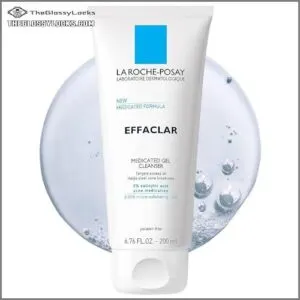
With 2% salicylic acid and lipo-hydroxy acid, La Roche-Posay’s Effaclar Medicated Gel Cleanser tackles hormonal acne without the harsh scrubbing.
You’ll see up to 47% less surface oil after regular use, while the formula gently unclogs pores and fades post-breakout dark spots.
It’s dermatologist-tested for sensitive skin and won’t strip your natural moisture barrier, making it a reliable option.
The lightweight, foaming texture works twice daily, making it your reliable first line of defense against stubborn adult breakouts, providing a gentle yet effective way to manage acne with 2% salicylic acid and lipo-hydroxy acid.
Best For: Adults with oily, combination, sensitive, or acne-prone skin seeking a gentle, clinically tested solution for stubborn breakouts and excess oil.
- Clinically reduces excess oil and breakouts without harsh scrubbing or irritation.
- Gentle, non-comedogenic formula suitable for sensitive and rosacea-affected skin.
- Fades dark spots and acne scars while improving skin texture and clarity.
- May cause initial purging or mild dryness, especially on very sensitive skin.
- Cooling menthol sensation isn’t preferred by all users.
- Squeeze tube packaging is less popular than a pump dispenser.
2. CeraVe Salicylic Acid Acne Wash
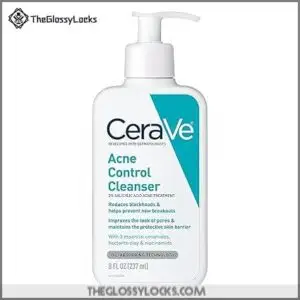
CeraVe’s gentle approach makes it a game-changer for adults who’ve sworn off harsh acne treatments.
This gel-to-foam cleanser combines 2% salicylic acid with purifying clay, effectively unclogging pores while maintaining your skin’s natural barrier.
The three essential ceramides and niacinamide work together to prevent the tight, stripped feeling that sends many running back to their old routines.
You’ll notice reduced breakouts and smoother skin texture within days, making it perfect for sensitive or combination skin types.
Best For: Adults and teens with oily, acne-prone, or sensitive skin seeking a gentle yet effective daily acne cleanser.
- Exfoliates and clears pores without stripping moisture
- Soothes and calms skin with ceramides and niacinamide
- Non-comedogenic, fragrance-free, and suitable for sensitive skin
- May cause dryness or irritation if overused or combined with other exfoliants
- Some users see limited improvement in mild acne
- Higher price point compared to basic drugstore cleansers
3. PanOxyl 10% Acne Foaming Wash
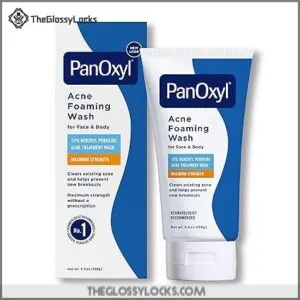
When bacteria throw a party on your skin, PanOxyl 10% crashes it hard.
This maximum-strength benzoyl peroxide wash kills over 99% of acne-causing bacteria within 15 seconds, making it your heavy-duty weapon against stubborn breakouts.
You’ll see results within days, though its powerful formula requires careful use—start with once daily and always follow with moisturizer.
It’s particularly effective for persistent adult acne on face, chest, and back when gentler options fail, using a maximum-strength benzoyl peroxide wash that can kill bacteria within 15 seconds.
Best For: People dealing with persistent, severe, or hormonal acne on the face, chest, or back who haven’t seen results with gentler treatments.
- Quickly kills over 99% of acne-causing bacteria, often delivering results within days.
- Maximum OTC strength clears existing breakouts and helps prevent new ones.
- Suitable for both oily and sensitive skin types, thanks to added moisturizers.
- Can cause dryness, redness, or irritation, especially at the start or with overuse.
- Not recommended for daily use on sensitive or dehydrated skin.
- Noticeable bleach smell and risk of bleaching fabrics during use.
4. Differin Acne Treatment Retinoid Gel
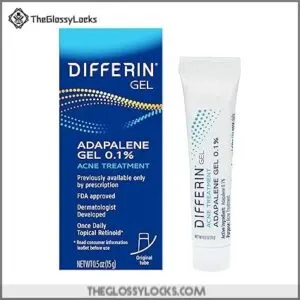
Remarkably, this over-the-counter retinoid packs prescription-strength power that’ll transform your skin’s cellular turnover process.
Differin Gel contains 0.1% adapalene, which works deep within pores to prevent clogged follicles and reduce inflammation at its source.
You’ll typically see up to 87% reduction in breakouts after 12 weeks of consistent nightly use.
While initial dryness and peeling are common during the adjustment phase, this water-based formula remains gentler than older retinoids, making it perfect for sensitive skin and providing a noticeable reduction in breakouts.
Best For: People with mild to moderate acne or sensitive, acne-prone skin seeking a gentle, effective, over-the-counter retinoid.
- Initial "purge phase" may worsen acne for the first 3-4 months
- Common side effects include dryness, irritation, and peeling during early use
- Requires daily, long-term commitment and sun protection for best results
- Clinically proven to reduce breakouts by up to 87% after 12 weeks of use
- Water-based, oil-free, fragrance-free, and suitable for sensitive skin
- Prevents new acne, unclogs pores, and helps improve skin texture and tone
5. La Roche-Posay Adapalene Acne Treatment
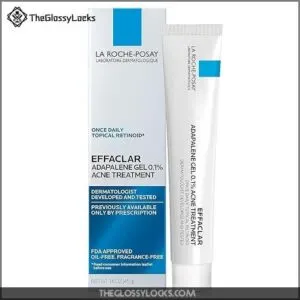
Another prescription-strength retinoid that’s now available over-the-counter, La Roche-Posay’s adapalene gel delivers the same 0.1% concentration as Differin but comes in a sealed tube that many users prefer.
You’ll apply a pea-sized amount once daily after cleansing, focusing on your entire face rather than spot-treating individual breakouts.
Clinical studies show significant reduction in both blackheads and whiteheads after 56 days of consistent use, with your skin gradually adjusting to minimize initial dryness or irritation that’s common with retinoids.
For ideal results, consider gentle cleansing techniques before application, ensuring you follow gentle methods to avoid irritation.
Best For: Adults and teens struggling with recurring or stubborn acne, blackheads, or whiteheads looking for an effective retinoid that’s easy to integrate into a nightly routine.
- Initial dryness, redness, or irritation is common as skin adjusts.
- Requires consistent long-term use for best results; not a quick fix.
- Not recommended for individuals who are pregnant, breastfeeding, or have extremely sensitive skin.
- Prescription-strength 0.1% adapalene provides proven acne-fighting results without a prescription.
- Noticeable improvement in skin texture and reduction of breakouts after consistent use.
- Non-comedogenic, oil-free, and fragrance-free formula suitable for sensitive and oily skin.
Managing Hormonal Acne
Beyond choosing the right products, you’ll need to address the underlying factors that fuel hormonal acne through targeted lifestyle changes.
Supporting your body’s natural hormone balance with stress management, gut health optimization, and consistent skincare habits creates the foundation for clearer skin that lasts, by also considering lifestyle changes.
Lifestyle Changes and Stress Reduction
Beyond skincare products, lifestyle changes substantially impact hormonal acne management.
Stress management techniques like meditation and deep breathing reduce cortisol levels that trigger breakouts.
Quality sleep helps regulate hormones, while regular exercise improves circulation and reduces stress.
Staying hydrated supports skin health and toxin elimination, and these simple modifications work alongside treatments to create clearer, healthier skin naturally.
Probiotics and Gut Health
Your gut-skin connection shapes hormonal acne more than you might expect.
Recent research reveals that gut microbiome imbalances can trigger inflammation, affecting your skin barrier and worsening adult acne symptoms.
- Beneficial probiotic strains like Lactobacillus rhamnosus can reduce acne lesions by 50% in clinical trials
- Short-chain fatty acids from healthy gut bacteria strengthen your skin barrier against breakouts
- Western diets high in processed foods disrupt gut microbiome balance, increasing inflammation
- Dietary impact studies show fiber-rich foods support both gut health and clearer skin outcomes
Emerging research supports using probiotics for acne to improve skin health through the gut-skin connection.
Maintaining a Consistent Skincare Regimen
Your skincare routine needs consistency to combat adult acne effectively.
Apply noncomedogenic products in the correct ingredient order – cleanser, treatments, moisturizer, then sunscreen.
Make seasonal skincare adjustments as needed, but maintain your core hormonal acne treatment regimen.
Regular exercise can help balance hormones and reduce acne triggers.
The long-term benefits of consistent product application outweigh temporary setbacks in your acne treatment journey, ensuring a more effective hormonal acne management.
Frequently Asked Questions (FAQs)
How do you get rid of hormonal acne in adults?
Like wrestling a stubborn storm that won’t pass, you’ll need targeted treatments to clear hormonal acne.
Use oral contraceptives, spironolactone, or topical retinoids to regulate hormones and reduce oil production effectively.
Which treatment is best for hormonal acne?
The most effective treatment depends on your specific hormonal patterns and acne severity. Oral contraceptives and spironolactone work best for many women, while topical retinoids help everyone.
What is the best routine for hormonal acne?
Picture waking up to painful, deep cysts along your jawline—it’s frustrating, but you’re not powerless. Start with gentle cleansing using salicylic acid, apply benzoyl peroxide, and maintain consistency.
What is the first line of treatment for hormonal acne?
You’ll want to start with topical retinoids like adapalene or tretinoin, which prevent pore clogging and reduce breakouts effectively. They’re considered the gold standard first-line treatment for hormonal acne.
Can hormonal acne appear during pregnancy?
Yes, hormonal acne can definitely appear during pregnancy due to increased progesterone levels, which stimulate oil production and create conditions for breakouts, especially during the first trimester.
How long does hormonal acne treatment take?
Hormonal acne treatment typically takes 3-6 months to show significant improvement.
Though you’ll notice some changes within 6-8 weeks of starting treatment.
Patience is key since hormones need time to rebalance.
Are there natural remedies for hormonal acne?
Looking for alternatives to conventional treatments? Natural remedies like zinc supplements, probiotics, stress management through sleep and exercise, and non-comedogenic skincare can help balance hormones and reduce inflammation naturally.
Does diet affect hormonal acne severity?
Diet can substantially impact your hormonal acne severity. High-sugar foods and refined carbs increase inflammation and oil production, while dairy (especially skim milk) can worsen breakouts through hormone disruption.
Can men develop hormonal acne too?
Men can definitely develop hormonal acne too. While it’s more common in women, testosterone fluctuations affect men’s oil production, especially during puberty, stress, or certain medical conditions, triggering breakouts.
Conclusion
Remember those stubborn breakouts that seem to have a mind of their own?
Successful hormonal acne treatment for adults requires patience and the right product combination.
You’ve now discovered five proven treatments that target both hormonal triggers and surface symptoms.
Start with gentler options like salicylic acid cleansers, then gradually introduce retinoids as your skin adapts.
Consistency beats perfection—stick with your routine for at least 12 weeks to see meaningful results.
Your clearer skin journey starts today.
- https://my.clevelandclinic.org/health/diseases/21792-hormonal-acne
- https://pmc.ncbi.nlm.nih.gov/articles/PMC6360964/
- https://www.aad.org/public/diseases/acne/derm-treat/hormonal-therapy
- https://www.aurorahealthcare.org/services/dermatology/acne/hormonal-acne
- https://www.bmj.com/content/381/bmj-2022-074349


